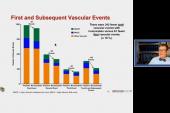New Data Reassure on Rivaroxaban’s Role in Frail PAD Patients
The analysis, from VOYAGER-PAD, suggests that fragile patients benefit from the therapy as much as nonfrail individuals.

Patients with PAD who meet criteria for frailty can reap similar benefits as their nonfrail counterparts when prescribed a combination of low-dose direct oral anticoagulant and aspirin following lower extremity revascularization, an analysis of the VOYAGER-PAD trial shows. For both groups, the drug combo reduced vascular and limb events.
Frail patients over age 75, which comprised one-quarter of the trial’s total population, had comparable safety and efficacy rates on the regimen versus nonfrail patients, and the risk-benefit-risk trade-off remained favorable at 3 years, researchers report in a paper published today in the Journal of the American College of Cardiology.
Prior analyses from VOYAGER-PAD have shown that low-dose rivaroxaban (Xarelto; Bayer/Janssen) plus aspirin reduces the risk of venous thromboembolism (VTE) compared with aspirin alone, and that the low-dose rivaroxaban combination therapy bests aspirin alone for the prevention of acute limb ischemia, amputation, CV events, and stroke in a PAD-only population. In the most recent update of the guidelines for the management of lower-extremity PAD, low-dose rivaroxaban combined with low-dose aspirin was given a class 1, level of evidence A recommendation in symptomatic PAD patients and in those who have had an endovascular or surgical revascularization to reduce the risk of MACE and major adverse limb events (MALE).
The new findings fill gaps in clinical trial data regarding medical therapies in fragile patients with PAD and provide reassurance to clinicians, said senior author Marc P. Bonaca, MD (University of Colorado School of Medicine, Aurora).
A recent update by the American Geriatrics Society to their Beers Criteria for potentially inappropriate medication use in older adults recommended apixaban (Eliquis; Bristol-Myers Squibb) over other oral anticoagulant agents in older patients affected by VTE or atrial fibrillation, and urged caution in using rivaroxaban in older adults, Bonaca added.
“I think that created a lot of confusion, so what we wanted to do was understand [whether] the vascular dose of rivaroxaban in PAD patients who were frail had an undue risk of harm without providing the same benefit,” he told TCTMD.
“What we found, lo and behold, was that they're higher risk for ischemic events and they derive the same benefit [as nonfrail patients] with the same benefit-risk ratio and should be treated, or at least offered this therapy. So, I think it's helpful because we tend to undertreat this population,” Bonaca added.
In an accompanying editorial, Umberto Campia, MD, MS and Giovanni Scimeca, MD (both Brigham and Women’s Hospital, Boston, MA), note that some of the undertreatment may stem from an erroneous perception that the risk of major bleeding or intracranial hemorrhage is higher than it actually is in frail patients given anticoagulants.
They say the study suggests that “presence of frailty should not be considered a contraindication to a combined antithrombotic regimen of aspirin plus low-dose rivaroxaban.”
Fewer Hospitalizations Seen
VOYAGER PAD randomized patients age 50 or older who were symptomatic and had undergone a successful limb revascularization in the previous 10 days to receive rivaroxaban 2.5 mg twice daily plus aspirin 100 mg daily or placebo plus aspirin 100 mg daily. Of the 6,564 patients, 1,674 (mean age 77 years; 40% female) met the prespecified definition of frailty: age > 75 years or weight ≤ 50 kg, or baseline estimated glomerular filtration rate (eGFR) < 50 mL/min/1.73 m2.
Frail patients were more likely than those who were nonfrail to be Asian and female and to have a higher prevalence of CV risk factors and comorbid disease, including hypertension, diabetes, heart failure, CAD, carotid artery disease, and prior limb amputation. By revascularization type, endovascular therapy was the more common strategy in the fragile group.
At 3 years, the rate of the composite of acute limb ischemia, major amputation for vascular causes, MI, ischemic stroke, or death from cardiovascular causes (primary efficacy endpoint) was 23.6% in frail patients on placebo versus 18.3% in nonfrail patients on placebo (HR 1.34; 95% CI 1.12-1.61).
I think it's helpful because we tend to undertreat this population. Marc P. Bonaca
For the individual components of the primary endpoint, fragile and nonfragile placebo patients had similar risk of MALE, but the fragile group had a greater risk of MACE driven by MI and CV death. Additionally, all-cause death occurred at a rate of 16.6% in the fragile group versus 8.7% in the nonfragile group (HR 2.06; 95% CI 1.62-2.61). Fragile placebo patients also had a greater risk for ISTH major bleeding relative to the nonfragile group (HR 2.30; 95% CI 1.53-3.47).
Rivaroxaban’s effect on the primary efficacy endpoint was not modified by frailty status: HR 0.93 (95% CI 0.75-1.15) in the frail group versus HR 0.83 (95% CI 0.72-0.97) in the nonfrail group (P for interaction = 0.37). The most notable benefits in frail patients on rivaroxaban were reductions in limb outcomes, including the composite of MALE, with the latter driven by a reduction in acute limb ischemia.
Frail patients on rivaroxaban also saw similar reductions in the secondary outcome of hospitalization due to coronary or peripheral causes compared with nonfrail patients.
Frailty status also did not modify the impact of rivaroxaban on the principal safety outcome of TIMI major bleeding: HR 1.54 (95% CI 0.82-2.91) in the frail group versus HR 1.37 (95% CI 0.84-2.23) in the nonfrail group (P for interaction = 0.65).
Both fragile and nonfragile patients on rivaroxaban also had similar reductions in total vascular events at 3 years.
Compared with nonfrail patients, those with frailty had higher rates of premature drug discontinuation at 3 years, primarily due to an invasive procedure or patient decision, with bleeding being an infrequent cause of discontinuation in both groups.
In a prespecified on-treatment analysis, rivaroxaban was associated with a lower rate of the primary endpoint compared with placebo with no difference between fragile and nonfragile patients. In a benefit-risk analysis, the investigators concluded that for every 10,000 frail patients treated with rivaroxaban for 1 year, 219 primary outcome events would be prevented at a cost of 64 TIMI major bleeds.
Frailty Assessments and Shared Decision-making
To TCTMD, Bonaca said knowing the numbers of events prevented adds additional context to shared discussions of rivaroxaban therapy.
“Patients with peripheral artery disease face a whole spectrum of adverse outcomes, . . . and it’s important to talk to them about acute limb ischemia, the risks of amputation, heart attack, stroke, and other things,” he said. “And when you [discuss] risks of bleeding and what that bleeding experience might be like, you can talk through the numbers in terms of events prevented or caused and . . . it makes it easier for patients to understand why they would want to consider taking a new therapy.”
In their editorial, Campia and Scimeca note that the investigators did not use a validated frailty score, but say that the proportion of VOYAGER-PAD patients who were frail matches up with what has been reported in the literature. Still, they advocate for a PAD-specific frailty assessment scale, adding that “evidence-based strategies should be a priority for vascular specialists to reduce the risk of adverse cardiovascular and limb events.”
Bonaca said while having such as specific score would be helpful, “even using very simple measures of frailty are reasonable in terms of identifying patients that are higher risk of both ischemic events and bleeding.” Additionally, frailty screening should be part of “a constant process of assessing comorbidities and benefit-risk of their therapies,” he said.
Another take-away from the findings, Bonaca added, is that the most frequent reasons for drug discontinuation in both fragile and nonfragile patients were not adverse events, but rather the need for an invasive procedure or a patient’s own decision.
“This is where having data is really critical [to help guide] when or if patients are going to restart therapy after the procedure . . . and understand the benefit-risk decision of stopping,” he said.
L.A. McKeown is a Senior Medical Journalist for TCTMD, the Section Editor of CV Team Forum, and Senior Medical…
Read Full BioSources
Canonico ME, MD, Low Wang CC, Hsia J, et al. Low-dose rivaroxaban plus aspirin in fragile patients after lower extremity revascularization. J Am Coll Cardiol. 2024;84:801-811.
Campia U, Scimeca G. Frailty in peripheral artery disease patients undergoing revascularization there is strength in antithrombotic therapy. J Am Coll Cardiol. 2024;84:812-14.
Disclosures
- VOYAGER PAD was funded by Bayer and Janssen Pharmaceuticals.
- Canonico and Bonaca report research grant/consulting funding to their institution from Abbott, Agios, Alexion Pharma Godo Kaisha, Amgen, Anthos Therapeutics, ARCA Biopharma, AstraZeneca Pharma India, AstraZeneca Pharmaceuticals LP, AstraZeneca UK, AstraZeneca Produtos Farmaceuticos, Atentiv, Bayer, Bayer (Proprietary) Limited, Bayer Aktiengesellschaft, Bayer Pharma, Better Therapeutics, Bristol Myers Squibb, CellResearch Corporation, Cleerly, Cook Regentec, CSL Behring, Eidos Therapeutics, EPG Communication Holdings, Esperion Therapeutics, Faraday Pharmaceuticals, HeartFlow, Insmed, Ionis Pharmaceuticals, IQVIA, Janssen Pharmaceuticals, Janssen Research and Development, Janssen Scientific Affairs, Lexicon Pharmaceuticals, LSG Corporation, MedImmune Limited, Medpace, Merck, Nectero Medical, Novartis, Novo Nordisk, Osiris, Pfizer, PPD Development, Prothena Biosciences, Regeneron, Sanifit Therapeutics, Sanofi, Silence Therapeutics, Stealth BioTherapeutics, VarmX, and WraSer.
- Campia and Scimeca report no relevant conflicts of interest.





Comments